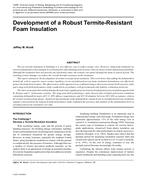
Development of a Robust Termite-Resistant Foam Insulation
The use of foam insulation in buildings is a very effective way to reduce energy costs. However, using foam insulation on exterior foundations is discouraged or even banned by some building codes in areas with very heavy termite infestation probability. Although the insulation does not provide any nutritional value, the termites can tunnel through the foam in search of food. The resulting termite damage can reduce the overall thermal resistance of the insulation.
This report summaries the development of termite-resistant foam insulation. This work shows that adding the deltamethrin termiticide with its superior insect contact repellency to an extruded polystyrene foam insulation formulation can effectively protect the foam from termites. The effectiveness of this approach was confirmed using a short-term extreme field exposure study and a long-term field performance study conducted in
The short-term study showed that deltamethrin provides significant protection of extruded polystyrene insulation against both R. flavipes and C. formosanus termites. The long-term field performance study showed that extruded polystyrene insulation containing deltamethrin meets all U.S. EPA efficacy requirements and ICC-Evaluation Services (ICC-ES) acceptance criteria for termite-resistant foam plastic. Analytical measurements of the deltamethrin content levels in extruded polystyrene insulation samples retrieved from the long-term field performance study confirmed the presence and stability of the deltamethrin level in extruded polystyrene insulation over time.
Presented at Thermal Performance of Exterior Envelopes of Whole Buildings X – December 2007
Units: Dual
Citation: Thermal Performance of Exterior Envelopes of Whole Buildings X
Product Details
- Published:
- 2008
- Number of Pages:
- 9
- File Size:
- 1 file , 1.6 MB
- Product Code(s):
- D-BldgsX153


